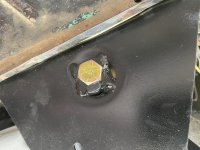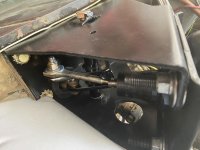the-glove
Jr. Member
I'm trying to finish off a hydroboost conversion and was testing the brakes today, but rear wheels are not stopping when stomping on the pedal. I have not tested the fronts yet.
1995 Astro hydroboost (junkyard and I replaced the seals) and MC (new Raysbestos).
Mounted on an angle bracket
New Borgeson dual return pump
Proportioning Valve (combination valve that came with Tom's Broncos vacuum brake kit. Not adjustable)
Front discs/Rear drums
I've installed everything and wanted to test the brakes on jack stands today before taking it on a road test. Put the rear axle on stands, started the engine and tested if the brakes overcome the engine torque with tranny in Drive as well as if it could stop the wheels if I gassed it with the brakes on. It works ok on the first but when I gassed it a bit while holding down the brakes the wheels could still move. My initial impression is that, when stopping the wheels as they spin in Drive, I thought it would stop the rear wheels quicker and higher up on the pedal when on stands since it doesn't have to overcome the weight and momentum of the car. They do stop, but I have to press a bit deeper than I would have thought.
The big problem though, is if I try to simulate a panic stop by stomping on the brakes as the wheels spin....I get nothing! The pedal feels fine, but the wheels don't stop. I have to let the pedal up then push with more normal driving pressure and it will stop. If I stomp on it again, the same thing happens.
Any ideas??? Is it the proportioning/combo valve? I know that in a panic stop proportioning/combo valves are supposed to lessen the pressure going to the rear drums so that they don't lock up more than the fronts. But it doesn't even seem to be slowing it down at all when I simulate a panic stop. Do I need to go to an adjustable proportioning valve?
Also, should I be concerned that with normal pedal pressure it isn't stopping the wheels with more authority in the first inch or two of the pedal? I need to press a bit further to get it to stop quicker. I would think if I'm on the road and needing to stop the full weight of the car it's going to be even worse. Or is just because these are the rear brakes and most of the braking power is in the front?
I bled the power steering/hydroboost system until my shoulders hurt. I did:
- Pitman arm off steering box.
- Filled pump reservoir then did 40 cycles of left and right turns of steering wheel until no more bubbles came up in reservoir
- Cranked engine with fuel pump off three times
- Did maybe 90-100 cycles of turning steering wheel to full lock left and right 5 times each then pumping brakes 3 times for each cycle. I was still getting some slight fluid rise and fall in reservoir at the end, but not really any bubbles or burping....and these were if I was turning the wheel at a faster speed.
- Turned engine on, warmed up for 2 mins, and did a bunch of turns and pedal presses
I bench bled the master cylinder and rear drums. Used gravity method for the rears using a hose in a bottle. Let run until no bubbles. I had tried vaccum bleeder kit first but air was getting into bleeder threads, even when covered in grease. I have not bled the fronts yet.
-
1995 Astro hydroboost (junkyard and I replaced the seals) and MC (new Raysbestos).
Mounted on an angle bracket
New Borgeson dual return pump
Proportioning Valve (combination valve that came with Tom's Broncos vacuum brake kit. Not adjustable)
Front discs/Rear drums
I've installed everything and wanted to test the brakes on jack stands today before taking it on a road test. Put the rear axle on stands, started the engine and tested if the brakes overcome the engine torque with tranny in Drive as well as if it could stop the wheels if I gassed it with the brakes on. It works ok on the first but when I gassed it a bit while holding down the brakes the wheels could still move. My initial impression is that, when stopping the wheels as they spin in Drive, I thought it would stop the rear wheels quicker and higher up on the pedal when on stands since it doesn't have to overcome the weight and momentum of the car. They do stop, but I have to press a bit deeper than I would have thought.
The big problem though, is if I try to simulate a panic stop by stomping on the brakes as the wheels spin....I get nothing! The pedal feels fine, but the wheels don't stop. I have to let the pedal up then push with more normal driving pressure and it will stop. If I stomp on it again, the same thing happens.
Any ideas??? Is it the proportioning/combo valve? I know that in a panic stop proportioning/combo valves are supposed to lessen the pressure going to the rear drums so that they don't lock up more than the fronts. But it doesn't even seem to be slowing it down at all when I simulate a panic stop. Do I need to go to an adjustable proportioning valve?
Also, should I be concerned that with normal pedal pressure it isn't stopping the wheels with more authority in the first inch or two of the pedal? I need to press a bit further to get it to stop quicker. I would think if I'm on the road and needing to stop the full weight of the car it's going to be even worse. Or is just because these are the rear brakes and most of the braking power is in the front?
I bled the power steering/hydroboost system until my shoulders hurt. I did:
- Pitman arm off steering box.
- Filled pump reservoir then did 40 cycles of left and right turns of steering wheel until no more bubbles came up in reservoir
- Cranked engine with fuel pump off three times
- Did maybe 90-100 cycles of turning steering wheel to full lock left and right 5 times each then pumping brakes 3 times for each cycle. I was still getting some slight fluid rise and fall in reservoir at the end, but not really any bubbles or burping....and these were if I was turning the wheel at a faster speed.
- Turned engine on, warmed up for 2 mins, and did a bunch of turns and pedal presses
I bench bled the master cylinder and rear drums. Used gravity method for the rears using a hose in a bottle. Let run until no bubbles. I had tried vaccum bleeder kit first but air was getting into bleeder threads, even when covered in grease. I have not bled the fronts yet.
-













